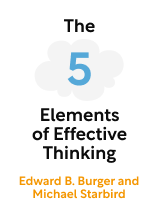

This article is an excerpt from the Shortform book guide to "The 5 Elements of Effective Thinking" by Edward B. Burger and Michael Starbird. Shortform has the world's best summaries and analyses of books you should be reading.
Like this article? Sign up for a free trial here.
What’s the best way to understand something beyond the facts? How can you truly master a subject or a skill?
When you know karate on a surface level, you pivot your feet in a certain way. When you understand karate deeply, you know why you pivot your feet that way. You’ve also mastered the basic skills before tackling advanced levels.
Continue reading to learn how to understand anything deeply.
How to Understand Anything Deeply
In The 5 Elements of Effective Thinking, Edward B. Burger and Michael Starbird discuss the element of earth, which the authors say represents the foundation of ideas that will serve as the basis for your thinking. They argue that, to think effectively, you must base your thinking on a deep understanding of your topic or problem. We all have a lot of knowledge that we take for granted, but, by exploring this knowledge as thoroughly as possible, we open our minds to the greater possibilities it offers. This discussion explores how to understand anything deeply and maintain a firm foundation of learning.
(Shortform note: The authors tend to define “effective thinking” through the processes detailed in their book rather than stating an explicit definition. But we can infer that “effective thinking” is similar or equivalent to the more commonly understood term “critical thinking,” which is an active process of thinking that involves understanding and applying the various levels of cognition to enhance one’s understanding.)
The authors discuss two ways you can approach fundamentals that can help you create a firm foundation:
Principle 1: Learn Beyond the Facts
Understanding deeply is not simply knowing or not knowing facts; it’s about understanding the “why” of those facts. Therefore, the authors advise that you don’t just learn what the facts are but instead learn about the facts. Understand their background, the connections between them, and their implications.
For example, if you’re learning karate, your instructor might tell you to pivot your feet in the direction of your punches. Knowing this fact is helpful, but not as beneficial as understanding the “why” of that fact: turning your foot in the direction of your punch allows you to put your whole body’s strength into the strike instead of just the strength of your arm.
(Shortform note: It may be more difficult to apply the principles of effective thinking to physical activities since we associate those more with athletic ability than with thought, but we have to learn how to move our bodies just as we have to learn everything else. Thinking effectively about your movement—understanding why you should move your body this way instead of that way—could help you improve your form and avoid injury when performing physical tasks.)
| Asking “Why Is This True?” Other education experts also emphasize the necessity of learning beyond the facts, suggesting that many of today’s students can succeed in the classroom without actually understanding the concepts they’re studying. This leads to uninformed citizens who, though they may have a lot of knowledge, are unable to apply that knowledge to the real world. Some of these experts’ recommendations involve using questioning to deepen that understanding, just as the authors suggest later in this book. Others have also pointed out that our definition of “fact” is not as universal or concrete as we might think. While most would agree that a fact is something that can be proven, many “facts” are also personal interpretations or beliefs. For example, it might be a fact that the sun rises in the east (provably true) but a person might also believe as a “fact” that certain political policies are better than others (personal belief). Exploring the “why” behind the facts we believe are true might provide insight into how accurate these facts are and whether we need to recategorize them as myths. |
Principle 2: Go Back to the Basics
The authors write that you shouldn’t try to tackle complex issues until you’ve thoroughly mastered the fundamentals. Understanding smaller, more basic aspects of a problem will allow you to understand more complex issues.
Thus, they advise that, when approaching a complex problem, you revisit the basic skills and knowledge base needed to master it. Mastering basic skills can help you manage a situation when circumstances change. When you come upon a problem that proves more challenging than you anticipated, go back and find the fundamental knowledge or skills that will help you proceed in your new situation. For example, a chef trying to perfect an advanced dish might revisit a simple but beloved recipe to find insights on what they could do better.
(Shortform note: Revisiting the basics before you start on your complex problem can prompt your brain to process that information more quickly thanks to a phenomenon called priming. This is when the brain shows increased responsiveness to certain stimuli when given prior stimulation that relates to the same information or thought processes.)
| Learning Framework Burger and Starbird’s theories of learning align in many ways with other psychologists’ insights. For example, educational psychologist Benjamin Bloom devised a classification method, Bloom’s Taxonomy, outlining how our brains absorb knowledge, much of which corresponds to Burger and Starbird’s theories. Bloom’s Revised Taxonomy describes four different levels of learning: • Factual knowledge (understanding discrete facts about an idea) • Conceptual knowledge (understanding the connections between the facts that comprise the whole of the idea) • Procedural knowledge (understanding how to apply factual and conceptual knowledge to perform a task related to the idea) • Metacognitive knowledge (understanding and reflecting on the process of your learning) Burger and Starbird’s earth classification corresponds strongly with Bloom’s first three groups here: factual, conceptual, and procedural knowledge, as both classification systems emphasize the importance of knowing basic facts and the relationships between them. Bloom’s fourth category listed above correlates with much of the ideas that Burger and Starbird outline in their other categories, as they move from understanding the facts themselves to understanding the processes of learning behind them. |

———End of Preview———
Like what you just read? Read the rest of the world's best book summary and analysis of Edward B. Burger and Michael Starbird's "The 5 Elements of Effective Thinking" at Shortform.
Here's what you'll find in our full The 5 Elements of Effective Thinking summary:
- The 5 principles for learning to think effectively
- What it means to learn beyond memorizing
- Why you need to be willing to change if you want to learn







Great job bring more